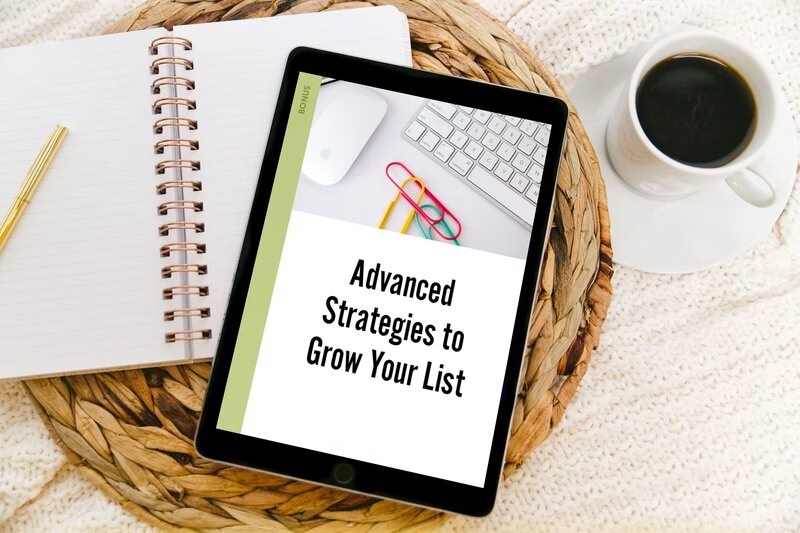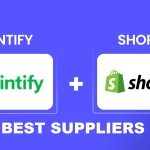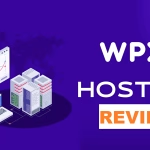Building an email list remains one of the most effective ways to grow your business and create lasting connections with your audience.
This guide will walk you through the essential strategies and techniques to build an email list from scratch, helping you create a valuable asset for your business from day one.
Email List Building Fundamentals 📧
The foundation of successful email list building lies in understanding why people subscribe to email lists and what motivates them to stay engaged.
Research shows that 59% of consumers say marketing emails influence their purchasing decisions, making email lists an invaluable tool for business growth.
Why Building an Email List Matters
Email marketing continues to deliver an impressive ROI, with studies showing an average return of $42 for every dollar spent. This remarkable efficiency makes building an email list a crucial priority for any business looking to establish sustainable growth.
Essential Steps to Build Your Email List
Building an email list is the foundation of a successful online business. Whether you’re just starting or looking to scale, these essential steps will help you attract, engage, and retain subscribers in 2025 and beyond.

1. Creating Compelling Lead Magnets
Lead magnets are the backbone of any successful email list-building strategy. They provide immediate value to your audience, encouraging them to exchange their email address for something they find useful.
Why Lead Magnets Work:
People are more likely to subscribe when they receive something valuable in return. A well-crafted lead magnet positions you as an authority and builds trust with your audience.
Popular Lead Magnet Types:
Comprehensive Guides and Ebooks: In-depth resources that solve a specific problem. For example, “The Ultimate Guide to Social Media Marketing in 2025.”
Exclusive Video Tutorials: Step-by-step videos that teach a skill or process, like “How to Create a High-Converting Sales Funnel.”
Interactive Worksheets: Tools that help users apply what they’ve learned, such as a budget planner or content calendar template.
Industry Reports and Statistics: Data-driven insights that provide actionable takeaways, like “2025 Trends in Digital Marketing.”
Templates and Checklists: Ready-to-use resources that save time, such as a blog post checklist or email campaign template.
Pro Tip: Tailor your lead magnet to your audience’s pain points. Use surveys or social media polls to identify what they need most.
2. Optimizing Sign-up Forms
Your sign-up forms are the gateway to your email list. If they’re not optimized, you’re leaving potential subscribers on the table. Here’s how to create forms that convert.
Key Elements of High-Converting Sign-up Forms:
Clear Value Proposition: Clearly state what subscribers will get. For example, “Get Your Free SEO Checklist Delivered Instantly!”
Minimal Field Requirements: Only ask for essential information (e.g., name and email). The fewer fields, the higher the conversion rate.
Mobile-Friendly Layout: Ensure your forms look great and function smoothly on all devices.
Strategic Placement: Use high-visibility areas like above the fold, at the end of blog posts, or as exit-intent popups.
A/B Testing Capabilities: Test different headlines, colors, and CTAs to find what works best.
Pro Tip: Use tools like OptinMonster or Thrive Leads to create and test high-converting forms without coding.
3. Implementing List Building Tools
In 2025, the right tools can make or break your list-building efforts. Here’s a breakdown of the essential tools you’ll need.
Essential Tools for Modern List Building:
Email Service Providers (ESP): Choose a reliable ESP like Beehiiv, Kit, or ActiveCampaign to manage your subscribers and send emails.
Landing Page Builders: Use tools like Leadpages or Unbounce to create dedicated landing pages for your lead magnets.
Form Creation Tools: Platforms like Thrive Leads or ConvertBox make it easy to design and embed forms on your website.
Analytics Platforms: Track your performance with Google Analytics or your ESP’s built-in analytics to measure growth and optimize campaigns.
Integration Solutions: Ensure your tools work seamlessly together. For example, integrate your ESP with your CRM or e-commerce platform.
Pro Tip: Automate your list-building process wherever possible. For instance, use Zapier to connect your forms with your ESP and CRM.
Bonus Tips for Maximizing List Growth
- Leverage Social Proof: Add testimonials or subscriber counts to your forms to build trust.
- Use Countdown Timers: Create urgency by adding a timer to your lead magnet offer.
- Segment from the Start: Use smart forms to collect additional data (e.g., interests) and segment subscribers from the beginning.
- Promote Your Lead Magnet: Share it on social media, mention it in podcasts, or include it in guest blog posts.
Advanced List Building Strategies
Building an email list in 2025 requires more than just basic opt-in forms. To stand out, you need advanced strategies that deliver value and engage your audience. Here are some cutting-edge tactics to supercharge your list-building efforts.

Content Upgrades: The Secret to Highly Targeted Leads
Content upgrades are one of the most effective ways to grow your email list. They involve offering a specific, high-value resource (like a checklist, template, or eBook) in exchange for an email address. The key is to make the upgrade highly relevant to the content your audience is already consuming.
Implementation Steps:
- Identify High-Performing Content: Use analytics tools to find your most popular blog posts or pages. These are prime candidates for content upgrades.
- Create Targeted Resources: Develop resources that complement the content. For example, if your blog post is about “10 Time Management Hacks,” offer a downloadable time-blocking template.
- Implement Delivery Systems: Use tools like Thrive Leads or ConvertBox to seamlessly integrate content upgrades into your posts.
- Track Conversion Rates: Monitor how well your upgrades perform and tweak them for better results.
Pro Tip: Content upgrades can boost conversions by up to 785% when done correctly. Always test different formats (PDFs, videos, or swipe files) to see what resonates most with your audience.
Interactive Elements: Engage and Convert
Interactive content is a game-changer for list-building. It not only captures attention but also provides personalized value, making visitors more likely to subscribe.
Effective Interactive Elements:
- Quizzes and Assessments: Offer a quiz like “What’s Your Marketing Style?” and deliver results via email.
- Calculators: Tools like ROI calculators or savings estimators are highly engaging.
- Surveys: Use surveys to gather insights while offering a free report or summary in exchange for an email.
- Virtual Consultations: Offer a free 10-minute consultation to capture leads.
Why It Works: Interactive content is highly shareable and creates a personalized experience, increasing the likelihood of conversions.
List Building Through Multiple Channels
Don’t rely on just one channel to grow your email list. Diversify your efforts across multiple platforms to maximize reach.

Social Media Integration: Turn Followers into Subscribers
Social media is a goldmine for list building. Here’s how to leverage it effectively:
Platform-Specific Strategies:
- Instagram Bio Links: Use tools like Linktree to direct followers to a lead magnet or landing page.
- Twitter Lead Generation Cards: Promote gated content directly within tweets.
- Facebook Lead Ads: Create ads that collect email addresses without requiring users to leave the platform.
- LinkedIn Content Upgrades: Share valuable resources in LinkedIn posts and direct users to a sign-up form.
Pro Tip: Run social media contests where entry requires an email address. This can quickly grow your list while boosting engagement.
Website Optimization: Turn Visitors into Subscribers
Your website is your most powerful list-building tool. Optimize it to capture leads at every touchpoint.
Key Areas to Focus On:
- Homepage Optimization: Add a prominent opt-in form or banner promoting your lead magnet.
- Blog Post Integration: Include inline opt-in forms or content upgrades within your posts.
- Resource Center Development: Create a dedicated library of gated resources.
- Exit-Intent Popups: Use tools like OptinMonster to capture leads before visitors leave your site.
Why It Works: A well-optimized website ensures you’re capturing leads at every stage of the customer journey.
Legal Compliance and Best Practices ⚖️
Building an email list isn’t just about growth—it’s about doing it ethically and legally. Here’s how to stay compliant in 2025.
GDPR Compliance: Protect Your Audience’s Privacy
The General Data Protection Regulation (GDPR) is a must-follow framework for list building, especially if you have EU subscribers.
Compliance Elements:
- Explicit Consent Mechanisms: Use checkboxes to ensure users actively opt-in.
- Privacy Policy Transparency: Clearly explain how you’ll use their data.
- Data Handling Procedures: Store and process data securely.
- Documentation Systems: Keep records of consent for auditing purposes.
Pro Tip: Use double opt-in to ensure subscribers genuinely want to join your list. This also improves list quality.
Email Marketing Regulations: Stay on the Right Side of the Law
In addition to GDPR, follow other email marketing regulations like the CAN-SPAM Act.
Key Considerations:
- CAN-SPAM Act Compliance: Include a clear unsubscribe link and your physical address in every email.
- Double Opt-In Implementation: Reduce spam complaints and improve deliverability.
- Privacy Protection Measures: Use encryption and secure servers to protect subscriber data.
- Unsubscribe Management: Honor opt-out requests promptly to maintain trust.
Why It Matters: Compliance builds trust with your audience and protects your business from legal issues.
Measuring List Building Success 📊
To optimize your efforts, you need to track the right metrics and analyze your performance
Key Performance Indicators (KPIs): What to Track
Monitor these essential metrics to gauge your list-building success:
- Conversion Rates: The percentage of visitors who sign up.
- Growth Rate: How quickly your list is expanding.
- Form Abandonment: Identify where users drop off in the sign-up process.
- Source Attribution: Determine which channels drive the most sign-ups.
Pro Tip: Use UTM parameters to track the performance of specific campaigns and channels.
Analytics Implementation: Set Up Proper Tracking
To measure success, you need robust analytics in place.
Required Elements:
- Goal Tracking: Set up goals in Google Analytics to track form submissions.
- Event Monitoring: Track interactions with forms, popups, and CTAs.
- User Behavior Analysis: Understand how users navigate your site before signing up.
- ROI Calculation: Measure the revenue generated from your email list.
Why It’s Important: Data-driven decisions lead to better results and higher ROI.
List Building Tools and Resources
The right tools can make or break your list-building efforts. Here are some top recommendations.

Email Service Providers (ESPs): Choose Wisely
Your ESP is the backbone of your email marketing strategy. Here are some popular options:
- Beehiiv: Highly recommended for its user-friendly interface and advanced features.
- MailChimp: Great for beginners.
- Kit (Formerley ConvertKit): Ideal for creators and bloggers.
- ActiveCampaign: Perfect for automation and segmentation.
- Klaviyo: Best for e-commerce businesses.
- Constant Contact: A reliable all-rounder.
Pro Tip: Choose an ESP that scales with your business and offers robust analytics.
Form Building Tools: Capture Leads Effectively
Your forms are the gateway to your email list. Use these tools to create high-converting forms:
- OptinMonster: Perfect for popups and exit-intent forms.
- Thrive Leads: A WordPress plugin with advanced targeting options.
- ConvertBox: Great for interactive forms and content upgrades.
- Leadpages: Ideal for creating standalone landing pages.
- SumoMe: A versatile tool for list building and analytics.
Why It Matters: Well-designed forms can significantly boost your conversion rates.
Maintaining List Health
A healthy email list is just as important as a growing one. Here’s how to keep your list in top shape.

List Cleaning: Remove Inactive Subscribers
Regularly clean your list to improve deliverability and engagement.
Maintenance Tasks:
- Bounce Handling: Remove invalid email addresses.
- Engagement Monitoring: Identify inactive subscribers.
- Re-Engagement Campaigns: Send win-back emails to re-engage dormant subscribers.
- Inactive Subscriber Management: Automatically remove subscribers who haven’t engaged in 6-12 months.
Pro Tip: A smaller, engaged list is more valuable than a large, unengaged one.
Segmentation Strategies: Deliver Personalized Content
The Segmentation ensures your emails are relevant and engaging.
Segmentation Criteria:
- Subscriber Behavior: Segment based on opens, clicks, and purchases.
- Demographics: Tailor content based on age, location, or job title.
- Purchase History: Send targeted offers to repeat customers.
- Engagement Levels: Create segments for highly engaged vs. casual subscribers.
Why It Works: Segmented campaigns generate 30% higher open rates and 50% higher click-through rates.
Conclusion
Building an email list from day one requires a strategic approach combining technical knowledge, marketing expertise, and consistent effort.
Success comes from implementing the right tools, creating valuable offerings, and maintaining healthy list practices while staying compliant with regulations.
FAQs
Building an email list can feel overwhelming, especially if you’re just starting. To help you navigate the process, here are answers to the most frequently asked questions about email list building in 2025.
1. How quickly can I build a substantial email list?
The speed at which you build your email list depends on your strategy, niche, and consistency. While some businesses see rapid growth through viral campaigns or paid ads, most organic efforts take 3 to 6 months to build a meaningful list. Focus on quality over quantity—engaged subscribers are more valuable than a large, unengaged list.
Pro Tip: Use lead magnets, social media promotions, and collaborations to accelerate growth.
2. What’s the best lead magnet format?
The best lead magnet format depends on your audience’s preferences and your industry. Common formats include:
- Ebooks and Guides: Great for in-depth education.
- Checklists and Templates: Perfect for actionable, step-by-step resources.
- Video Tutorials: Ideal for visual learners.
- Quizzes and Assessments: Engage users with interactive content.
Pro Tip: Test different formats and use analytics to determine what resonates most with your audience.
3. How often should I send emails to new subscribers?
Start with a welcome sequence spaced 2-3 days apart to nurture new subscribers. After that, maintain regular communication based on your audience’s engagement. A good starting point is 1-2 emails per week but adjust based on open rates and click-through rates.
Pro Tip: Use automation to send personalized emails based on subscriber behavior.
4. What’s a good conversion rate for sign-up forms?
Average conversion rates for sign-up forms range from 1-5%, but this varies by industry and offer type. For example, a well-optimized form with a high-value lead magnet can achieve 10% or higher.
Pro Tip: Use A/B testing to improve your conversion rates over time.
5. How do I prevent list fatigue?
List fatigue occurs when subscribers become disengaged due to over-communication or irrelevant content. Prevent it by:
- Segmenting Your List: Send targeted emails based on subscriber behavior and preferences.
- Maintaining Quality: Ensure every email provides value.
- Respecting Preferences: Allow subscribers to choose how often they hear from you.
Pro Tip: Regularly clean your list by removing inactive subscribers.
6. Should I buy email lists?
Never buy email lists. This practice violates regulations like GDPR and CAN-SPAM, damages your sender’s reputation, and results in poor engagement. Focus on organic list building to attract genuinely interested subscribers.
Pro Tip: Build trust with your audience by being transparent and providing value.
7. How do I optimize for mobile users?
With over 60% of emails opened on mobile devices, optimizing for mobile is crucial. Here’s how:
- Use Responsive Design: Ensure your forms and emails look great on all screen sizes.
- Minimize Form Fields: Keep forms short and easy to complete.
- Increase Touch-Target Sizes: Make buttons and links easy to tap.
Pro Tip: Test your forms and emails on multiple devices before launching.
8. What’s the ideal number of form fields?
Less is more. Start with just an email address and, if necessary, a name. Additional fields (e.g., phone number or company name) can reduce conversions. Only ask for the information you truly need.
Pro Tip: Use progressive profiling to collect more data over time without overwhelming new subscribers.
9. How do I reduce form abandonment?
Form abandonment occurs when users start but don’t complete their sign-up form. Reduce it by:
- Simplifying Forms: Use fewer fields and clear instructions.
- Communicating Value: Highlight the benefits of subscribing.
- Using Multi-Step Forms: Break longer forms into smaller, manageable steps.
Pro Tip: Add trust signals like testimonials or privacy assurances to boost confidence.
10. What’s the best time to show pop-up forms?
The best timing depends on your audience and website behavior. Test different triggers, such as:
- Exit-Intent: Show the form when users are about to leave.
- Scroll-Depth: Trigger the form after users scroll 50-75% of the page.
- Time-Based: Display the form after 30-60 seconds on the page.
Pro Tip: Avoid showing pop-ups too early, as this can annoy visitors.








